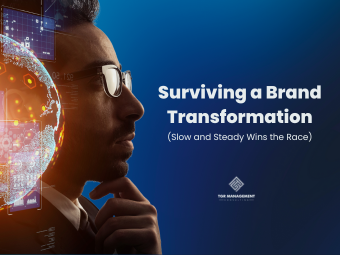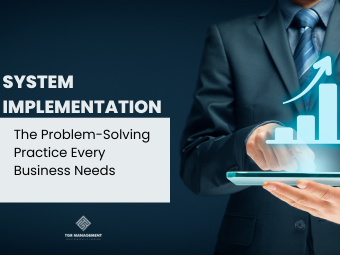
Rebranding is something we most often associate with marketing. It may bring to mind a dynamic, creative process where a group of writers and artists shout fun logo ideas at each other.
While, yes, rebranding centers on an organization’s outward-facing image, it often necessitates internal changes to ensure consistency between the new brand identity and the organization’s culture, values, and practices. Anyone can change their logo and call it a day. Surviving a complete brand transformation is something else entirely.
Organizations are living and breathing things. As a business or non-profit evolves, it’s crucial to reassess your mission and ensure your public image aligns with your present values.
That’s what happened with the San Diego Youth Symphony. In an episode of The Business of Non-Profits, Dr. Michael Remson discusses their careful approach to implementing brand changes. Let’s talk about everything they did right!
How SDYS Knew it Was Time to Rebrand
When you hear the words “San Diego Youth Symphony,” what does it make you think of? As Dr. Michael Remson and his team members considered this question, they realized they didn’t like the answer. The name had a lot of things going for it, including over 70 years of history. The problem was…it was also very limiting.
San Diego limited them to the San Diego area – but they have programs beyond. Youth – what does that word even mean? Teenagers? Pre-schoolers? Young Adults? And then there was that last word, “symphony.” A term associated with men and women holding classical instruments and dressed in suits and gowns. This association creates an assumed limitation based on privilege and income.
As their work expanded to bring musical education back to students of all ages, areas, and incomes, they found that they were stretching their brand too far. People who might be looking for the kinds of programs they offer would hesitate to reach out based on the limitations above. A “brand transformation” was needed. This would require a new brand strategy…A Mega Brand Strategy.
Mega brands are all around us. Proctor and Gamble is a great example of a mega brand done well. A successful mega brand takes the power of a brand and extends it across other related products to drive growth. Sort of like taking equity out of your house to build an addition. But how do you do this without dragging down both brands?
Finding the Solution
We’ve already mentioned that SYDS knew they were stretching their brand identity too thin. In some cases, brand expansion works great! However, stretch too far, and you begin to dilute your brand. Remember when Harley Davidson tried to break into the world of perfume? Not their best strategy. The question was: how could SYDS maintain its expansion without diluting the brand they’d already developed?
SYDS has developed several programs to serve various communities. This includes the Opus project – which partners with schools and community groups to restore and enhance music programs. Then there’s Chimes, an early childhood development program. These are just two examples of many. They have developed and continue developing educational programs and services for families, schools, and individuals of all ages.
If each of these programs serves different functions for different groups of people, how could they capture the essence of each program under one brand?
They found the solution within the problem. If they wanted to continue expanding into different programs, they could treat each program as its unique brand (something they’d already been doing). This is how they came to the “mega-brand” strategy. This approach would help SDYS overcome the challenge of unifying its many diverse programs under one brand.
Balancing Speed and Success
We’ve seen bigger for-profits rush a new product or service to the market only to realize that their clients weren’t ready or didn’t like the change. Coke rolled out “New Coke” in 1985, attempting to compete with Pepsi’s sweeter flavor. But nobody wanted Coke to taste like Pepsi. Perhaps if they’d taken more time and done more research, they’d have avoided this costly mistake.
SYDS didn’t rush the process.
Like any organizational change, multiple steps are required to rebrand your organization successfully. This is especially true if you’re an already established and beloved brand – which SYDS is.
They had identified the problem and devised an idea for a solution – but to ensure it was a long-term solution, they’d have to put in some extra leg work. They hired an external marketing team to work alongside their internal team and began months of development.
From there, it was a domino effect. Their investment in time and manpower allowed them to clarify their branding for the many programs they already had. In turn, this helped them establish essential qualities to be carried forward to their megabrand. This groundwork pushed them toward the most critical re-branding step: choosing a name.
Nothing Simple About Choosing a Name
Those of us outside the world of marketing and branding might assume that naming your brand is as simple as tossing ideas around for an hour and writing down the names that sound most impressive or reflective of your ideals. But, as with any organizational change, there’s a process.
SDYS’s hired marketing team came up with over 200 names. They then narrowed it down to the final 6, each with a clear and definite reason for being a candidate. They presented these six names to Dr. Remson and the marketing director. They knew which one they preferred…but they didn’t stop there. They diffused the presentation among the different branches of the processes, including stakeholders and constituents.
Inclusion is critical here. By including every team member in their thought process and explaining their preference clearly and concisely, Dr. Remson and his team could narrow in on the best name while ensuring that every level of the organization felt included in this process.
Implementing KeyNote – Final Takeaways
They landed on KeyNote – with the tag: “Cradle to College Music Education.”
It’s genuinely fascinating to see how these things develop. In this episode, Dr. Remson details the many questions, concerns, and back-and-forth discussions they underwent. But what I find most interesting about it is the time and thought they put into every aspect of this change.
By engaging an expert, laying the foundation, and collaborating with stakeholders, San Diego Youth Symphony initiated a process to establish a name that would align with their existing programs, support growth, and resonate with their broader mission.
The same is true of most organizational changes. Considering the impact and importance of every decision, and taking the time to include your team in those decisions, does a lot to mitigate mistakes, fallout, confusion, etc., throughout those changes.
Whether you’re undergoing a brand transformation or just attempting to switch to a new payroll system: slow and steady wins the race every time.
Tiffany Rosik, Founder and CEO of TGR Management Consulting, excels in employing technology strategies to drive growth and implement organizational changes for Fortune 1000 companies. By mentoring Project Team Leaders on team dynamics and fostering self-sustaining models, she ensures consistent experiences and results while facilitating transformation. Connect with or follow Tiffany Rosik on LinkedIn.




